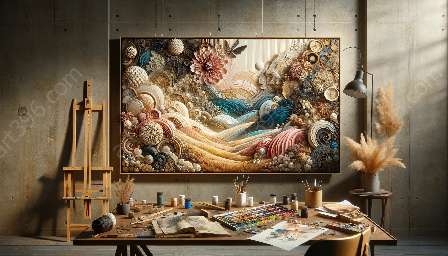Mixed media art is a dynamic and eclectic form of artistic expression that combines various materials and techniques to create evocative and multidimensional pieces. At the heart of mixed media art lies the transformative qualities of everyday materials, which hold the power to transcend their original purpose and become integral components in the creative process.
The Significance of Materials Used in Mixed Media Art
One of the defining aspects of mixed media art is the utilization of diverse materials, ranging from traditional art supplies to found objects and everyday items. This multifaceted approach allows artists to incorporate a broad spectrum of textures, colors, and forms into their work, breaking free from the constraints of singular mediums. By embracing a wide array of materials, artists can infuse their creations with layers of meaning and symbolism, establishing a rich tapestry of visual and tactile elements.
Everyday materials, such as newspaper clippings, fabric scraps, bottle caps, and discarded packaging, are often repurposed in mixed media art. Through careful manipulation and strategic juxtaposition, these materials undergo a remarkable metamorphosis, shedding their mundane identities to assume new and profound significance within the context of the artwork. This transformative process imbues the artwork with a sense of history and narrative, inviting viewers to engage with the underlying stories woven into the very fabric of the piece.
Exploring the Transformative Qualities of Everyday Materials
The transformative qualities of everyday materials in mixed media art are evident in their ability to undergo unconventional treatments and alterations. A common practice in mixed media art involves altering the physical properties of materials, such as distressing paper, aging fabric, or rusting metal to introduce elements of texture and patina. These processes imbue the materials with a sense of antiquity and weathered charm, adding depth and character to the artwork.
Moreover, everyday materials serve as vehicles for experimentation and innovation in mixed media art. Artists often push the boundaries of traditional artistic conventions by employing unorthodox methods to manipulate materials, such as burning, tearing, or layering them to create intricate surfaces and complex compositions. This spirit of exploration allows for the discovery of unexpected visual effects and the emergence of unconventional aesthetics, enhancing the artistic allure of mixed media creations.
The Impact of Materials on the Artistic Process
Within the realm of mixed media art, everyday materials play a pivotal role in shaping the artistic process. Their transformative qualities inspire artists to approach their work with a sense of openness and adaptability, as they seek to harness the inherent potential of each material. Embracing the unpredictable nature of these materials, artists explore new avenues of expression and challenge conventional notions of artistic form, resulting in the creation of art that defies categorization and invites contemplation.
Furthermore, the transformative qualities of everyday materials encourage a sustainable and eco-conscious approach to artmaking, as artists repurpose and reimagine common objects, contributing to the reduction of waste and the promotion of environmental awareness through their creative endeavors.
In Conclusion
Mixed media art thrives on the transformative qualities of everyday materials, harnessing their potential to elevate the artistic process and enrich the visual landscape. By imbuing mundane objects with new significance and infusing artwork with layers of narrative and texture, artists create immersive and captivating pieces that resonate with viewers on a profound level. The exploration of transformative qualities in mixed media art opens a world of possibilities, where the ordinary becomes extraordinary, and the overlooked finds its voice in the realm of artistic expression.

